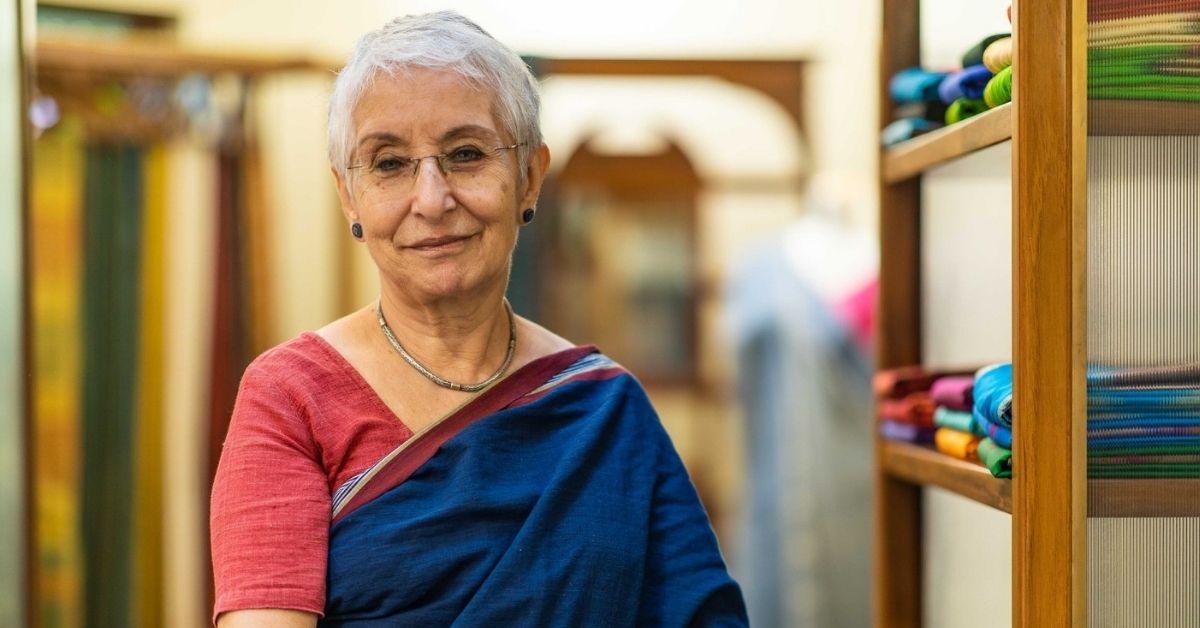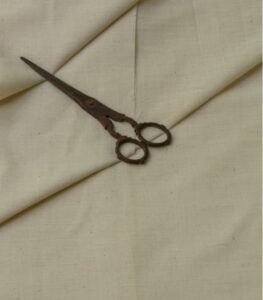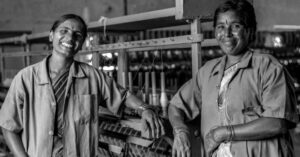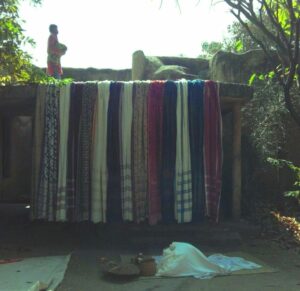74-YO Revives The Cotton Industry’s Lost Glory With Malkha, The Freedom Fabric
Uzramma is using malkha (amalgamation of mulmul and khadi), a fabric that is all-encompassing in the sense of generating livelihood, promoting a sustainable way of life, and pushing for environment-friendly living.

“Just as in a jungle one senses the presence of an animal one cannot see, I could sense, as I entered the weavers’ world, something important just out of sight, that might transform that world, or be the key to a golden future for Indian cotton hand weaving.”
The words of the mononymous Uzramma—who has been attempting to restore the 3000-year-old legacy of India’s cotton handloom tradition for the last 20 years—hit hard. She has been pushing to reinstate the autonomy of the country’s small growers, ginners, spinners, dyers and weavers. To do this, she’s using malkha (amalgamation of mulmul and khadi), a fabric that is all-encompassing in the sense of generating livelihood, promoting a sustainable way of life, and pushing for environment-friendly living.

In the early 19th century, India was the largest producer of cotton, and dominated the world’s textile export market. But today, the story reads differently. The big spinning mills that the country uses now were introduced by the British. Since these mills were located in England, the Brits would have to carry cotton yarn from India to England. For this, they would compress the cotton to a block, also known as baling, and the material would attain a rigidity that was almost wood-like. After the shipments would reach England, this cotton block would be decompressed (unbaling). This entire process would take away from the elasticity, strength and colour retention of the cotton. India has since followed the same process.
This is where 76-year-old Uzramma stepped in. “Now, India grows mostly American cotton, having lost sight of the incredible varieties we had been growing for centuries,” she says, adding, “History records the fine Dhakai muslin and the chintz exported to Europe, but India’s real strength lay in the coarse cotton cloth woven by ordinary people for their own use. The small weavers who sold laterally to visiting traders within local markets thrived for at least two millennia, till the British decided, after the industrial revolution, that this polished, home-grown system was inimical to their manufacturing interests.”
‘What of the cotton farmer?’
“Indian agriculture is a vast patchwork of small farms, spread over a diverse countryside that varies in climate, soils and access to water,” says Uzramma. “The way cotton is grown and the way it is treated are integral parts of their [the weavers’] way of life, which is essentially small-scale and diverse in nature.”

She adds, “The introduction of spinning machinery designed to suit mass production is an anomaly. The farmer suffers by being forced to grow cotton for this machinery, a single variety that has taken over the cotton fields of India, that needs irrigation and attracts pests, that can’t stand up to the floods and droughts that are endemic to the Indian climate. The hand weaver gets only the one kind of yarn the machines can make, losing the diversity of yarn that underpins regional specialization of fabrics. We have become dependent on a technology that calls the shots, that dominates both farmers and weaver.”
The making of…
Uzramma was born in Hyderabad. Raised in a family that had a strong footing in politics, she grew up aware of the fact that privilege and social consciousness move together. Her uncle was an early leader of the Communist Party of India, and her grandmother fought against the purdah system, and was also a member of the legislative assembly. Despite her family’s progressiveness, Uzramma was engaged to be married against her will at the age of 19, and had her first child at 21. She never got to complete her college education.
During her 10-year stay in England with her businessman husband from 1979-89, Uzramma developed an interest in artisanal crafts. “Learning goldsmithing, engraving, and the coordination of the hand, eye and brain changed my way of thinking,” she recalls. When she returned to India, she began volunteering at the Andhra Pradesh Handicrafts Development Corporation Ltd, wherein she would help in developing stronger colour palettes for Kondapalli toys and Etikoppaka lacquerware. After she got in touch with Dastkar (a Delhi-based crafts organisation), one of the founders suggested she launch the organisation’s Andhra chapter, which Uzramma set up in 1996. This catapulted her journey towards malkha fabric, with which she is now synonymous.
In the ’80s, a few scientists who had set up the Patriotic and People-Oriented Science and Technology (PPST) Foundation supported Uzramma’s research into cotton. Together, they began looking into the development of a cotton yarn based on the idea that cotton textiles were central to the people’s economy. While she was still working with Dastkar’s Andhra chapter, she started experimenting with the idea of growing cotton and weaving cloth not based on revivalist ideology, but as a movement that would be contemporary and economically sustainable. In 2005, Uzramma founded the Decentralised Cotton Yarn Trust (DCYT). The idea was to make yarn specifically for the handloom, revive the farmer-spinner-ginner-dyer-weaver chain, and transfer the ownership of the means of production to the people in the chain. This is how malkha was born.
Behind the spindles
Malkha, also known as the ‘freedom fabric’ has many attributes that stand out. Because Uzramma has removed the baling-unbaling process from its manufacturing, the final product has bounce, tenacity and brilliant colour retention, and is also breathable. Moreover, the fabric uses only natural dyes. Malkha’s blog states, “Blue is natural indigo dyed in traditional cold fermentation vats; the yellow is pomegranate rind with harda; a touch of kasimi turns it grey-green. Catechu heartwood is brown. All of the above are natural plant dyes, while red, the only exception, is non-toxic alizarin.”

The fabric has two spinning units in Ellanthakunta and Thangallapally, and the cotton delivered to these is only ginned, and never baled. Four weaving units exist in Ellanthakunta, Thangallapally and Pachnuru in Telangana, and Kaza in Andhra Pradesh. Uzramma’s initiative supports both weavers working in both loom sheds as well as at their homes. Fabric is sent to Machilipatnam and Gujarat to be traditionally printed with seasoned teakwood blocks. According to Malkha’s website, the idea is to enable each unit, no matter at what step it is in the cotton-making process, to become financially independent.
The fabric has forayed into men’s, women’s and children’s garments, and is vied for by renowned designers including Sabyasachi and Wendell Rodericks. A malkha store has also been set up in Finland and Japan.
“In the beginning, weavers were a little hesitant in taking up malkha,” Uzramma recalls, adding, “Now, we have a waiting list of weavers who want to sign up with the fabric. They’re paid good waves, the best of them earn Rs 15,000 per month, which is also why malkha doesn’t come too cheap.”
In five years, the fabric grew from 2,500 metres a month to 8,000-10,000 metres. The Malkha Trust works with over 120 artisans in cotton yarn spinning. During the lockdown, these artisans were supported from the Trust’s own pocket. They work democratically, six days a week, and get three weeks of paid leaves. This way of working is unheard of in the current cotton-industry, which is riddled with debt and suicide.
“Where I want to ultimately see the Indian handloom industry is a 10-mile walk. I want to work with organic cotton, I want to produce different varieties of cotton, train artisans to be the owners of their local economy, and have more stores. But as of now, I’ve managed to walk only an inch,” Uzramma says.
The way forward
Uzramma is practical, and aware that she may not be able to see the results she wants in her lifetime. The septuagenarian says, “You must have the vision to walk the long road, where you might not see the results, but a road that leaves results for the coming generations.”
India has over four million weavers. “Every civilisation has its own identity and ours was a handloom. When you lose your identity, there is a sense of loss,” she says.
This is the same loss Uzramma feels India can recover from. In her bid to go local, in many ways, she is on a path to revive the country’s lost legacy.
(Edited by Yoshita Rao)
If you found our stories insightful, informative, or even just enjoyable, we invite you to consider making a voluntary payment to support the work we do at The Better India. Your contribution helps us continue producing quality content that educates, inspires, and drives positive change.
Choose one of the payment options below for your contribution-
By paying for the stories you value, you directly contribute to sustaining our efforts focused on making a difference in the world. Together, let’s ensure that impactful stories continue to be told and shared, enriching lives and communities alike.
Thank you for your support. Here are some frequently asked questions you might find helpful to know why you are contributing?


This story made me
-
97
-
121
-
89
-
167













